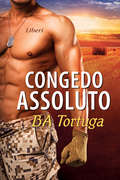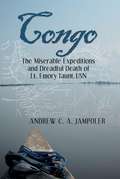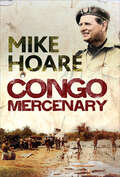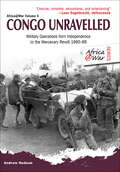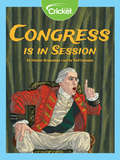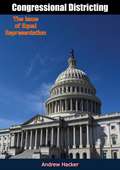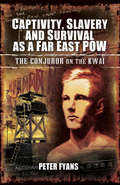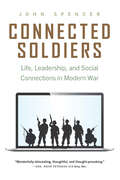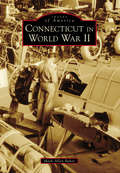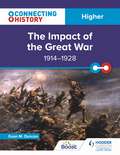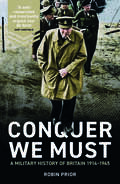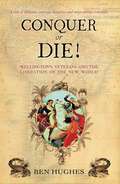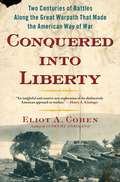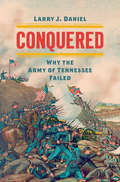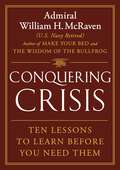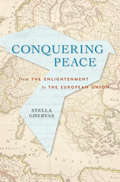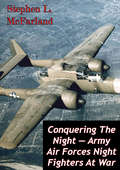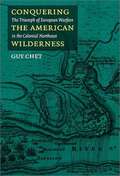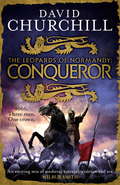- Table View
- List View
Congo
by Andrew C. JampolerLauded for his ability to tell compelling, true adventure stories, award-winning author Andrew C.A. Jampoler has turned his attention this time to a young American naval officer on a mission up the Congo River in May 1885. Lt. Emory Taunt was ordered to explore as much of the river as possible and report on opportunities for Americans in the potentially rich African marketplace. A little more than five years later, Taunt, 39, was buried near the place he had first come ashore in Africa. His personal demons and the Congo's lethal fevers had killed him. In 2011, to better understand what happened, Jampoler retraced Taunt's expedition in an outboard motorboat. Striking photographs from the author's trip are included to lend a visual dimension to the original journey.Readers join Taunt in his exploration of some 1400 miles of river and follow him on two additional assignments. A commercial venture to collect elephant ivory in the river's great basin and an appointment as the U.S. State Department's first resident diplomat in Boma, capital of King Leopold II's Congo Free State, are filled with promise. But instead of becoming rich and famous, he died alone, bankrupt, and disgraced. Jampoler's account of what went so dreadfully wrong is both thrilling and tragic. He provides not only a fascinating look at Taunt's brief and extraordinary life, but also a glimpse of the role the United States played in the birth of the Congo nation, and the increasingly awkward position Washington found itself as stories of atrocities against the natives began to leak out.
Congo Mercenary
by Michael Hoare‘I make no apologies for being a mercenary soldier. Quite the reverse. I am proud to have led 5 Commando. I am proud to have fought shoulder to shoulder with the toughest and bravest band of men it has ever been my honor to command. I am proud that they stood when all else failed.’ In July 1964, four years after gaining independence from Belgium, the Democratic Republic of the Congo came under threat from an armed rebellion that spread rapidly through the country. To suppress the rebels and bring the unrest and bloodshed in the country under control, Congolese officials enlisted the help of mercenary leader Mike Hoare. Working alongside military officials, Hoare assembled a band of several hundred men that became known as ‘5 Commando’. In Congo Mercenary, Hoare tells the story of the role that these men played in the rebellion, describing in gripping detail how this band of mercenaries were recruited, trained, and how they swept through the country. His team undertook four campaigns in just 18 months during which they fought rebels, liberated Stanleyville, freed European hostages and brought order back to the Democratic Republic of the Congo. Hoare’s experiences in the Congo and his involvement in suppressing the Simba rebellion were hugely significant from a political and a military standpoint. His influence, however, did not stop there. This account of his time in the Congo was first published in 1967 and had a huge cultural impact, as well, contributing to the glorification of the mercenary lifestyle in magazines and pulp novels, and even inspiring the 1978 war film The Wild Geese starring Richard Burton and Roger Moore.
Congo Unravelled: Military Operations from Independence to the Mercenary Revolt 1960–68 (Africa at War #6)
by Andrew HudsonA concise, gripping history of the resource-rich yet poverty-wracked nation’s instability and military conflict in the 1960s. Includes maps and photos.Post-independence events in the Republic of the Congo are a veritable Gordian knot. The ambitions of Congolese political leaders, Cold War rivalry, Pan-Africanism, Belgium’s continued economic interests in the country’s mineral wealth, and the strategic perceptions of other southern African states all conspired to wrack Africa’s second largest country with uprisings, rebellions, and military interventions for almost a decade.Congo Unravelled solves the intractable complexity of this violent period by dispassionately outlining the sequence of political and military events in the troubled country. It systematically reviews the first military attempts to stabilize Congo after independence, and the two distinguishing campaigns of the decade—the United Nations military operations to end the secession of the Katanga Province, and the Dragon Operations led by Belgian paratroopers, supported by the US Air Force, launched to end the insurgency in the east—are chronicled in detail. Finally, the mercenary revolt—which tainted the reputation of the modern mercenary in Africa—is described. Lesser known military events—Irish UN forces cut off from the outside world by Katangese gendarmes and mercenaries, and a combined operation in which Belgian paratroopers were dropped from US Air Force C-130 Hercules aircraft and supported by a mercenary ground force to achieve humanitarian ends—go far toward resolving the enigma surrounding post-independence Congo.Praise for the Africa@War books:“A groundbreaking series concept . . . They are recommended as professional military education references.” —Charles D. Melson, Chief Historian, U.S. Marine Corps“Splendid . . . admirably balanced, handy histories.” —Cybermodeler
Congress Is in Session
by Denver BrunsmanAmerica's path to revolution was paved by the great discussions of the Continental Congress, which gathered to address grievances against Great Britain. Adamant that the Colonies remain under British rule, King George III fueled the flames of American independence.
Congressional Districting: The Issue of Equal Representation
by Andrew HackerTHE SUPREME COURT’S decision in the case of Baker v. Carr, handed down in the spring of 1962, opened the way for reform of antiquated and inequitable patterns of representation in state legislatures. Over the ensuing twelve months, districting arrangements have been challenged in many states, and in several of them the legislatures have convened to draw up new districts which better reflect their actual population distribution.The Court’s decision has raised a number of issues, including the question whether the drive for more equal representation in the state legislatures will affect the United States Congress. The Brookings Institution therefore asked Prof. Andrew Hacker, of the Depart. of Government, Cornell University, to prepare a problem paper that would examine the present congressional districts from the viewpoint of the problems that might arise in connection with reapportionment in the states. The objective was a brief informative analysis drawing largely on available materials, with an early deadline precluding much new research.Mr. Hacker’s report approaches this subject from several vantage points. Among these are: the constitutional and historical background of congressional districting; state and judicial action as it applies to the Congress; reasons for the disproportion between votes cast and seats won; and the extent and consequences of inequalities in representation in the House of Representatives. Mr. Hacker indicates that the House does not give an equal voice to all of its constituents, and that prevailing inequities may become even more pronounced since the forces opposing reform feel strongly that justice is on their side, and the courts have yet to indicate how far they will go in applying the doctrine of equal representation enunciated in Baker v. Carr—or, indeed, whether they will apply it at all to congressional districts.—Robert Calkins
Conjuror on the Kwai: The Incredible Life of Fergus Anckorn
by Peter FyansCaptivity, Slavery and Survival as a Far East POW is the incredibly moving story of Gus Anckorn, a British soldier who was captured by the Japanese and held for over three and a half years. Before the war, Gus was a magician and throughout the war, entertained both fellow soldiers and Japanese guards with his tricks.Gus has a brilliant sense of humor and a 'tell it as it is' attitude which got him into a number of scrapes with both the Japanese and his own side. He has a remarkable humility to his character and is extremely endearing, both in the book and face to face guaranteeing massive media attention.Gus experienced terrible ordeals that no one should have to face. He should have been killed on four or five occasions, but remarkably survived due to quick thinking and good luck. Gus also reveals the heartache of leaving his fiancee behind and not knowing if he would ever see her again.This is an incredibly moving book and will surely be considered as one of the classic Far East POW stories. Gus is still alive and active today, very publicity focused and well connected. He still holds the unique claim of being the youngest ever member of the Magic Circle and is now currently their oldest ever member. He is also a member of the Masons. Gus has appeared on BBC TV when they arranged for him to meet a Japanese POW camp guard on the bridge at Kwai.
Conn Iggulden's Khan Series 5-Book Bundle
by Conn IgguldenFrom the co-author of The Dangerous Book for Boys, the Khan series is a triumph of historical fiction--a bold, epic account bursting with gritty realism and exhilarating action. Now this eBook bundle assembles the entire series--Birth of an Empire, Lords of the Bow, Bones of the Hills, Empire of Silver, and Conqueror--sparing no detail, from the Great Khan's first conquest and the heights of his unprecedented empire, to his brutal ancestral legacy and the rise of Kublai Khan. GENGHIS: BIRTH OF AN EMPIRE "Invigorating . . . zesty historical fiction, the kind with plenty of unbridled combat, accurate research, rampaging hordes and believable characters."--USA Today Genghis Khan was born Temujin, the son of a khan, raised in a clan of hunters and driven by a singular fury: to survive in the face of death, to kill before being killed. Through a series of courageous raids, Temujin's legend grew until he was chasing a vision: to unite many tribes into one, to make the earth tremble under the hoofbeats of a thousand warhorses, to subject all nations and empires to his will. GENGHIS: LORDS OF THE BOW "Readers who enjoy well-researched tales of historical adventure with an emphasis on political intrigue, exotic settings, and military conflict will enjoy the ride."--Library Journal For centuries, primitive tribes have warred with one another. Now, under Genghis Khan, they have united as one nation to face the ultimate test: the great, slumbering walled empire of the Chin. In Yenking--modern-day Beijing--the Chin will make their final stand. But Genghis will strike with breathtaking audacity, never ceasing until the emperor himself is forced to kneel. GENGHIS: BONES OF THE HILLS "Page-turning . . . a sweeping historical saga [that] will appeal to fans of gritty combat fiction."--Booklist As Genghis enters a strange new land of towering mountains and arid desert, he stirs an enemy greater than any he has met before. Shah Ala-ud-Din Mohammed has under his command thousands of fierce Arab warriors, teeming cavalry, and terrifying armored elephants. But another battle is taking shape--between two of Genghis's feuding sons. Soon the most powerful man in the world must choose a successor, touching off the most bitter conflict of all. KHAN: EMPIRE OF SILVER "Epic . . . alpha-male fiction . . . The book has much to teach about a time and a people long shrouded in legend."--The Wall Street Journal The Great Khan is dead--and his vast empire, forged through raw courage, tactical brilliance, and indomitable force, hangs in the balance. Even as the sons of Genghis Khan maneuver for supremacy, the Khan's armies extend his reach farther than ever before, into southern China and across the rugged mountains of Russia to the vulnerable heart of Europe, where the most courageous warriors the West commands await the coming onslaught. CONQUEROR "A rip-roarin' read, and inspiration to go and sack a few cities on your own."--Kirkus Reviews A succession of ruthless leaders have seized power in the wake of the Great Khan's death--all descendants of Genghis, but none with his indomitable character. It is Kublai--refined and scholarly, always considered too thoughtful to take power--who will devise new ways of warfare and conquest as he builds the dream city of Xanadu. His gifts will serve him well when an epic civil war breaks out among brothers, the outcome of which will literally change the world.
Connected Soldiers: Life, Leadership, and Social Connections in Modern War
by John SpencerJohn Spencer was a new second lieutenant in 2003 when he parachuted into Iraq leading a platoon of infantry soldiers into battle. During that combat tour he learned how important unit cohesion was to surviving a war, both physically and mentally. He observed that this cohesion developed as the soldiers experienced the horrors of combat as a group, spending their downtime together and processing their shared experiences. When Spencer returned to Iraq five years later to take command of a troubled company, he found that his lessons on how to build unit cohesion were no longer as applicable. Rather than bonding and processing trauma as a group, soldiers now spent their downtime separately, on computers communicating with family back home. Spencer came to see the internet as a threat to unit cohesion, but when he returned home and his wife was deployed, the internet connected him and his children to his wife on a daily basis. In Connected Soldiers Spencer delivers lessons learned about effective methods for building teams in a way that overcomes the distractions of home and the outside world, without reducing the benefits gained from connections to family.
Connecticut Yankees at Antietam (Civil War Ser.)
by John BanksStories of New England soldiers who perished in this bloody battle, based on their diaries and letters. The Battle of Antietam, in September 1862, was the single bloodiest day of the Civil War. In the intense conflict and its aftermath across the farm fields and woodlots near Sharpsburg, Maryland, more than two hundred men from Connecticut died. Their grave sites are scattered throughout the Nutmeg State, from Willington to Madison and Brooklyn to Bristol. Here, author John Banks chronicles their mostly forgotten stories using diaries, pension records, and soldiers&’ letters. Learn of Henry Adams, a twenty-two-year-old private from East Windsor who lay incapacitated in a cornfield for nearly two days before he was found; Private Horace Lay of Hartford, who died with his wife by his side in a small church that served as a hospital after the battle; and Captain Frederick Barber of Manchester, who survived a field operation only to die days later. This book tells the stories of these and many more brave Yankees who fought in the fields of Antietam. Includes photos
Connecticut in World War II (Images of America)
by Mark Allen BakerWith the attack on Pearl Harbor by the Empire of Japan on December 7, 1941, and the United States� entry into World War II, our nation turned to Connecticut�as it did during World War I�for munitions, clothing, and other goods. And Connecticut answered the call: Manchester Mills increased silk production, Waterbury brass producers altered their manufacturing lines, and Bridgeport�s Remington Arms�which had produced 50 percent of the US Army�s small arms cartridges in World War I�increased its mass production capabilities. By the time Electric Boat, Hamilton Propellers, Pratt & Whitney, and many other Connecticut companies tallied up their production back in 1945, it amounted to over $8 billion in war contracts.
Connecting History: Higher The Impact of the Great War, 1914–1928
by Euan M. DuncanExam board: SQALevel: HigherSubject: HistoryFirst teaching: September 2018First exam: Summer 2019Fresh stories, fresh scholarship and a fresh structure. Connecting History informs and empowers tomorrow's citizens, today.Bringing together lesser-told narratives, academic excellence, accessibility and a sharp focus on assessment success, this series provides a rich, relevant and representative History curriculum.> Connect the past to the present. Overarching themes of social justice, equality, change and power help students to understand the importance of events and issues, then and now.> Go far beyond other resources. With respect and aspiration for the transformative power of History, this series incorporates the latest research, challenges old interpretations and embeds diverse experiences throughout.> Follow a clear and consistent structure. The key issues in the specification form the chapters in each book, and the content descriptors are subheadings within the chapters. Finding the information that you need has never been easier.> Meet the demands of the assessments. Connecting History develops the knowledge and skills for success, with appropriate breadth, depth and pace. The narrative and sources take centre stage and the authors model the process of answering questions effectively through that narrative, ensuring that students have enough key points to achieve full marks. End-of-chapter activities consolidate and extend learning.> Benefit from pedagogic and academic expertise. The authors are highly experienced teachers and examiners who know how to spark critical curiosity in students. Each book has been rigorously reviewed by an academic from the University of Glasgow, so you can rest assured that the content is accurate and up to date.
Connecting History: National 4 & 5 The Era of the Great War, 1900–1928
by Alec JessopExam board: SQALevel: National 4 & 5Subject: HistoryFirst teaching: September 2017First assessment: Summer 2018Fresh stories, fresh scholarship and a fresh structure. Connecting History informs and empowers tomorrow's citizens, today.Bringing together lesser-told narratives, academic excellence, accessibility and a sharp focus on assessment success, this series provides a rich, relevant and representative History curriculum.> Connect the past to the present. Overarching themes of social justice, equality, change and power help students to understand the importance of events and issues, then and now.> Go far beyond other resources. With respect and aspiration for the transformative power of History, this series incorporates the latest research, challenges old interpretations and embeds diverse experiences throughout.> Follow a clear and consistent structure. The key issues in the N5 specification form the chapters in each book, and the content descriptors are subheadings within the chapters. Finding the information that you need has never been easier.> Meet the demands of the assessments. Connecting History develops the knowledge and skills for success, with appropriate breadth, depth and pace. The narrative and sources take centre stage and the authors model the process of answering questions effectively through that narrative, ensuring that students know all the key points that they need to. Activities throughout each chapter consolidate and extend learning.> Benefit from pedagogic and academic expertise. The authors are highly experienced teachers and examiners who know how to spark critical curiosity in students. Each book has been rigorously reviewed by an academic from the University of Glasgow, so you can rest assured that the content is accurate and up to date.
Connecting History: National 4 & 5 The Era of the Great War, 1900–1928
by Alec JessopExam board: SQALevel: National 4 & 5Subject: HistoryFirst teaching: September 2017First assessment: Summer 2018Fresh stories, fresh scholarship and a fresh structure. Connecting History informs and empowers tomorrow's citizens, today.Bringing together lesser-told narratives, academic excellence, accessibility and a sharp focus on assessment success, this series provides a rich, relevant and representative History curriculum.> Connect the past to the present. Overarching themes of social justice, equality, change and power help students to understand the importance of events and issues, then and now.> Go far beyond other resources. With respect and aspiration for the transformative power of History, this series incorporates the latest research, challenges old interpretations and embeds diverse experiences throughout.> Follow a clear and consistent structure. The key issues in the N5 specification form the chapters in each book, and the content descriptors are subheadings within the chapters. Finding the information that you need has never been easier.> Meet the demands of the assessments. Connecting History develops the knowledge and skills for success, with appropriate breadth, depth and pace. The narrative and sources take centre stage and the authors model the process of answering questions effectively through that narrative, ensuring that students know all the key points that they need to. Activities throughout each chapter consolidate and extend learning.> Benefit from pedagogic and academic expertise. The authors are highly experienced teachers and examiners who know how to spark critical curiosity in students. Each book has been rigorously reviewed by an academic from the University of Glasgow, so you can rest assured that the content is accurate and up to date.
Conquer - The Story of Ninth Army, 1944-1945
by Colonel William J. Thompson Colonel Theodore W. Parker Jr.Conquer: The Story of Ninth Army recounts in great and glorious detail the U.S. Ninth army as it campaigned against Nazi Germany in Europe during World War II. The Ninth Army reached France in September 1944 in time to play a leading role in the reduction of Brest and Brittany; further battles awaited them during the November Offensive and the counterattack against the Ardennes offensive. Their march into Germany saw further bitter conflicts and actions along the Roer, the Rhine, the Ruhr and the Elbe, before the Ninth Army was finally able to rest as part of the occupation forces in defeated of Germany. Richly illustrated with photos and maps of the actions of the Ninth Army in the ETO."Conquer: The Story of Ninth Army is intended to present in broad form a brief account of that Army's activities-- tactical, administrative, and logistical. Considerations of space, time, and proportion have generally limited the mention of individual units to divisions and larger. In Ninth Army, however, as in any modern American army, these were only one-half of the troop strength. The other half comprised the large number of corps and army troops-- cavalry, antiaircraft, engineer, chemical, field artillery, medical, military police, ordnance, quartermaster, signal, tank, and tank destroyer--the "supporting" troops, without whom the job could not have been done. And it is to these, most of whom wore the Ninth Army shoulder patch, that I wish to pay particular tribute here, without detracting in any way from the fine performance of the larger units."--Lt.-Gen. W. H. Simpson commander of the 9th Army.
Conquer We Must: A Military History of Britain, 1914-1945
by Robin PriorA major new account of Britain’s military strategy between 1914–1945, including the two world wars and everything betweenThe First and Second World Wars were separated by a mere two decades, making the period 1914–1945 an unprecedentedly intense and violent era of history. But how did Britain develop its complex military strategy during these wars, and how were decisions made by those at the top?Robin Prior examines the influence politicians had on military operations, in the first history to assess both world wars together. Drawing uniquely on both military and political archives and previously unexamined sources Prior explores the fraught relationships between civilian and military leaders: from Lloyd George’s remarkably interventionist stance on military tactics during the First World War to Churchill’s near-constant arguments with American leaders during the Second. Conquer We Must tells the complex story of this military decision-making, revealing how politicians attempted to control strategy—but had little influence on how the army, navy, and air force actually fought.
Conquer or Die!
by Ben HughesIn 1815, just after the battle of Waterloo, over 6,000 British volunteers sailed across the Atlantic to aid Simon Bolivar in his liberation of Gran Columbia from her Spanish oppressors. The expeditions were plagued with disaster from the start, when one ship sank shortly after leaving Portsmouth with the loss of almost 200 lives. Those who reached the New World faced disease, wild animals, mutiny and desertion. Conditions on campaign were appalling, massacres were commonplace, rations crude, pay infrequent and supplies insufficient. Nevertheless, those who endured made key contributions to Bolivar's success. This book tells the fast-paced and entertaining story of the British volunteers from the raising of the regiments in Britain to the perils of campaigning to their defiant stand at the battle of Carabobo. Drawing on the volunteers' memoirs, letters and journals, supported by unpublished documents and newspaper reports, Conquer or Die! is the result of research across two continents. It is the first narrative on the subject for over eighty years.From the Hardcover edition.
Conquered into Liberty
by Eliot A CohenAmericans often think of the Civil War as the conflict that consolidated the United States, including its military values and practices. But there was another, earlier, and more protracted struggle between "North" and "South," beginning in the 1600s and lasting for more than two centuries, that shaped American geopolitics and military culture. Here, Eliot A. Cohen explains how the American way of war emerged from a lengthy struggle with an unlikely enemy: Canada. In Conquered into Liberty, Cohen describes how five peoples--the British, French, Americans, Canadians, and Indians--fought over the key to the North American continent: the corridor running from Albany to Montreal dominated by the Champlain valley and known to Native Americans as the "Great Warpath." He reveals how conflict along these two hundred miles of lake, river, and woodland shaped the country's military values, practices, and institutions. Through a vivid narration of a series of fights-- woodland skirmishes and massacres, bloody frontal assaults and fleet actions, rear-guard battles and shadowy covert actions--Cohen explores how a distinctively American approach to war developed along the Great Warpath. He weaves together tactics and strategy, battle narratives, and statecraft, introducing readers to such fascinating but little-known figures as Justus Sherwood, loyalist spy; Jeduthan Baldwin, self-taught engineer; and La Corne St. Luc, ruthless partisan leader. And he reintroduces characters we thought we knew--an admirable Benedict Arnold, a traitorous Ethan Allen, and a devious George Washington. A gripping read grounded in serious scholarship, Conquered into Liberty will enchant and inform readers for decades to come.
Conquered: Why the Army of Tennessee Failed (Civil War America)
by Larry J. DanielOperating in the vast and varied trans-Appalachian west, the Army of Tennessee was crucially important to the military fate of the Confederacy. But under the principal leadership of generals such as Braxton Bragg, Joseph E. Johnston, and John Bell Hood, it won few major battles, and many regard its inability to halt steady Union advances into the Confederate heartland as a matter of failed leadership. Here, esteemed military historian Larry J. Daniel offers a far richer interpretation. Surpassing previous work that has focused on questions of command structure and the force's fate on the fields of battle, Daniel provides the clearest view to date of the army's inner workings, from top-level command and unit cohesion to the varied experiences of common soldiers and their connections to the home front. Drawing from his mastery of the relevant sources, Daniel's book is a thought-provoking reassessment of an army's fate, with important implications for Civil War history and military history writ large.
Conquering Crisis: Ten Lessons to Learn Before You Need Them
by Admiral William H. McRaven#1 New York Times bestselling author Admiral McRaven tells stories from his life and career that illustrate the principles of effective leadership during times of crisis. Throughout his 40-year career, Admiral McRaven has experienced every manner of calamity imaginable. From managing failed hostage rescues to responding to student unrest, McRaven has learned how to successfully navigate crises—those moments that push the limits of your experience and challenge your confidence, when leadership skills alone may not be enough.Conquering Crisis provides a new set of tools for facing these stressful moments with poise. It breaks crises down into five phases assess, report, contain, shape, and manage—and provides concrete steps to come out the other side stronger. With incredible personal stories, thought-provoking parables, and memorable lessons, Admiral McRaven sheds light on the ways we can rise to the occasion in times of crisis and act as leaders, no matter the situation.
Conquering Peace: From Enlightenment to the European Union
by Stella GhervasA bold new look at war and diplomacy in Europe that traces the idea of a unified continent in attempts since the eighteenth century to engineer lasting peace. Political peace in Europe has historically been elusive and ephemeral. Stella Ghervas shows that since the eighteenth century, European thinkers and leaders in pursuit of lasting peace fostered the idea of European unification. Bridging intellectual and political history, Ghervas draws on the work of philosophers from Abbé de Saint-Pierre, who wrote an early eighteenth-century plan for perpetual peace, to Rousseau and Kant, as well as statesmen such as Tsar Alexander I, Woodrow Wilson, Winston Churchill, Robert Schuman, and Mikhail Gorbachev. She locates five major conflicts since 1700 that spurred such visionaries to promote systems of peace in Europe: the War of the Spanish Succession, the Napoleonic Wars, World War I, World War II, and the Cold War. Each moment generated a “spirit” of peace among monarchs, diplomats, democratic leaders, and ordinary citizens. The engineers of peace progressively constructed mechanisms and institutions designed to prevent future wars. Arguing for continuities from the ideals of the Enlightenment, through the nineteenth-century Concert of Nations, to the institutions of the European Union and beyond, Conquering Peace illustrates how peace as a value shaped the idea of a unified Europe long before the EU came into being. Today the EU is widely criticized as an obstacle to sovereignty and for its democratic deficit. Seen in the long-range perspective of the history of peacemaking, however, this European society of states emerges as something else entirely: a step in the quest for a less violent world.
Conquering The Night — Army Air Forces Night Fighters At War [Illustrated Edition] (The U.S. Army Air Forces in World War II #1)
by Stephen L. McfarlandIncludes 16 photos illustrationsThe author traces the AAF's development of aerial night fighting, including technology, training, and tactical operations in the North African, European, Pacific, and Asian theaters of war. In this effort the United States never wanted for recruits in what was, from start to finish, an all-volunteer night fighting force.For combatants, a constant in warfare through the ages has been the sanctuary of night, a refuge from the terror of the day's armed struggle. On the other hand, darkness has offered protection for operations made too dangerous by daylight. Combat has also extended into the twilight as day has seemed to provide too little time for the destruction demanded in modern mass warfare.In World War II the United States Army Air Forces (AAF) flew night-time missions to counter enemy activities under cover of darkness. Allied air forces had established air superiority over the battlefield and behind their own lines, and so Axis air forces had to exploit the night's protection for their attacks on Allied installations. AAF night fighters sought to deny the enemy use of the night for these attacks. Also, by 1944 Allied daylight air superiority made Axis forces maneuver and resupply at night, by air, land, and sea. U.S. night fighters sought to disrupt these activities as an extension of daylight interdiction and harassment efforts. The AAF would seek to deny the enemy the night, while capitalizing on the night in support of daylight operations.
Conquering the American Wilderness: The Triumph of European Warfare in Colonial New England
by Guy ChetWhile not ignoring the sea of blood that washed the interactions between English colonists and Native Americans, Chet (history, University of North Texas) does not dwell on it. He finds that historians have over-emphasized a distinctly American style of warfare, and argues that in fact it was mostly a development of European approaches.
Conqueror (Leopards of Normandy 3): The ultimate battle is here
by David ChurchillFrom the co-author of the No.1 bestselling Wilbur Smith novel, War CryTheLeopards of Normandy trilogy concludes as Duke William prepares to take England, and his rivals, by storm. This real-life game of thrones lead to the defining the moment of English history: Hastings, 1066, and is a must-read for fans of Conn Iggulden, Bernard Cornwell and Ken Follett. 'An exciting mix of medieval betrayal, violence and sex' Wilbur Smith It began with a promise. It will end at Hastings.William of Normandy, sworn heir to the English throne, is no longer the boy Duke but a loyal and proven warrior. Few dare challenge him, but England is an irresistible prize.The handsome, ambitious Harold Godwinson and the Viking Hardrada are both determined to stake a claim. William faces his greatest ever battle: deny his own destiny or conquer the land he was born to rule.History will be written in the blood of those who fall.Readers love The Leopards of Normandy trilogy 'A wonderful end to a magnificent trilogy''I now know where Game of Thrones got most of its plot from''Well written, compelling, action, good characters - you name it - this is seriously worth reading!''History brought vividly to life''Wonderful storytelling and historical detail'
Conqueror (Leopards of Normandy 3): The ultimate battle is here
by David ChurchillFrom the co-author of the No.1 bestselling Wilbur Smith novel, War Cry The Leopards of Normandy trilogy concludes as Duke William prepares to take England, and his rivals, by storm. This real-life game of thrones lead to the defining the moment of English history: Hastings, 1066, and is a must-read for fans of Conn Iggulden, Bernard Cornwell and Ken Follett. 'An exciting mix of medieval betrayal, violence and sex' Wilbur Smith It began with a promise. It will end at Hastings.William of Normandy, sworn heir to the English throne, is no longer the boy Duke but a loyal and proven warrior. Few dare challenge him, but England is an irresistible prize.The handsome, ambitious Harold Godwinson and the Viking Hardrada are both determined to stake a claim. William faces his greatest ever battle: deny his own destiny or conquer the land he was born to rule.History will be written in the blood of those who fall. Readers love The Leopards of Normandy trilogy 'A wonderful end to a magnificent trilogy''I now know where Game of Thrones got most of its plot from''Well written, compelling, action, good characters - you name it - this is seriously worth reading!''History brought vividly to life''Wonderful storytelling and historical detail'
